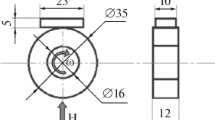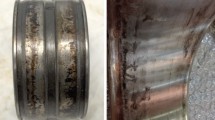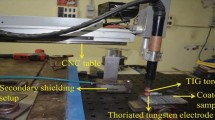Abstract
Tribological performance of bearing steels through the use of nano-additive oil lubrication and the hard-coated surfaces was studied. Hard coatings like DLC, TiAlN and CrN were deposited onto the bearing steels using Physical Vapour Deposition (PVD) technique. The tribological experiment was performed in accordance to ASTM G77 test method by using block-on-ring test. The test parameters include an incremental loading pressed on the sliding surfaces in a range of 0 N to 60 N, and the effect of interface temperature was investigated. All bearing steels functioned satisfactorily with low friction under very, thin nano-additive oil film. The hard-coated bearing steels enhanced the wear performance in comparison to that of a finely polished bearing steel. The interface temperature increases with the wear damage, whereby the mating sliding surface prone to severe adhesive wear at larger contact loadings.
Access provided by Autonomous University of Puebla. Download conference paper PDF
Similar content being viewed by others
Keywords
1 Introduction
Machine failures were happened because of poor tribological performance, ie. insufficient lubrication. This has resulted in a localized, high temperature generated between the two sliding surfaces, in which experienced high friction on a metal-to-metal contact area region [1]. The reduction of friction contributes to the reduction of energy loss by frictional heat. The reduction of wear can prolong the lifetime of machine components. Lubrication and protective coatings are some of the most important aspects of tribology, because of their role in reducing the friction between the pairs of contacting surfaces and protecting them from the wear. Therefore, this study is centered on the experimental investigations on the tribological performance of hard coatings applied to bearing steels, and these surfaces were tested under nano-additive oil lubrication. The block-on-disk tribometer in accordance to ASTM G77 test method was selected and suitable to tribological performance of the coated tribosystem bearing steels.
2 Methodology and Materials
The block-on-ring tribometer was used to determine the frictional behaviour and to identify the wear mechanisms of the test samples (see Fig. 1). The tribological experiment was performed in accordance to ASTM G77 test method under specific test parameters and operating conditions. The test parameters include an incremental loading pressed on the sliding surfaces in a range of 0 N to 60 N, angular speed of 1,400 rpm, and the experiment was done at room temperature. The measurement of temperature on the location near to the tool pin/ring sliding surfaces was also recorded. The test samples consist of two mating materials; a tool pin Ø14 × L14 mm and a ring Ø40 mm. The tool pin material was made of AISI 52100 bearing steel. Hard coatings were prepared and deposited onto the bearing steels by using Physical Vapour Deposition (PVD) technique. The coatings investigated in this study were Diamond-like Carbon (DLC), Titanium Alumina Nitride (TiAlN) and Chromium Nitride (CrN) coatings. The mean hardness values of the test samples were 642 HV (uncoated), 678 HV (CrN), 770 HV (TiAlN) and 871 HV (DLC). The average surface roughness of the test samples was Ra = 0.09 µm. A low-viscous oil contained additives with nano boundary lubrication properties, that has an average viscosity value of 96 cSt, was used in this study.
3 Results and Discussion
Figure 2 shows the measurements of friction coefficient and friction power as a function of the ring revolutions. It is seen that no improvement was noted on the friction coefficient and the frictional power, and even when testing the ball bearings under nano-additive oil lubrication. This is explained by effective lubrication effect [2], in which the presence of the nano particles in the oil has improved the load carrying ability of the pressurized oil between the pairs of pin/ring contacting surfaces [3]. Thereby, separating the pin/ring sliding surfaces with a very thin oil film. Due to no significant influence of the hard-coated and uncoated bearing steels on the frictional characteristics, the rest of the discussion is focused on the wear characteristics (Fig. 3). The positive influence of hard-coated surfaces on the wear performance is explained in forms of wear volume ratio (Fig. 3 left), wear rate (Fig. 3 right), and the observation on the worn surfaces of the coated test pins at the maximum concentrated loading of 60 N (see Fig. 4). Testing of all tool pins deposited with the hard coatings led to low wear loss. This is clearly seen in Fig. 3 (right), where the lowest wear loss was obtained with the CrN-coated pin, followed by TiAlN- and DLC-coated pins. Markedly highest wear loss was contributed by the steel-steel mating materials. It was furthermore clear that the coated-surfaces can promote the best adhesion to the bearing steel sliding surfaces as seen on the microscope images of the worn test pins at the maximum contact loading in Fig. 4. This explained that the surface properties of the protective, hard coatings like the hardness and adhesion bonding between the coating/substrate are important [4]. This allows the coating to prolong the lifetime of the bearing steels, and even the bearing steel can function satisfactorily with the presence of the very thin oil film like the nano-additive (Fig. 5).
4 Conclusion
The present study adopted a block-on-ring tribometer to investigate the hard-coated and uncoated bearing steels under nano-additive oil lubrication. The tribosystem hard-coated bearing steel is greatly beneficial to reduce wear, thereby prolong the lifetime of bearing steels. With the presence of a very thin, nano-additive oil film on the bearing steels, adhesive wear can be avoided and frictional heat effects can be reduced.
References
Sulaiman, M.H., Farahana, R.N., Bienk, K., Nielsen, C.V., Bay, N.: Effects of DLC/TiAlN-coated die on friction and wear in sheet-metal forming under dry and oil-lubricated conditions: experimental and numerical studies. Wear 438–439, 203040 (2019). https://doi.org/10.1016/j.wear.2019.203040
Sulaiman, M.H., Raof, N.A., Dahnel, A.N.: The investigation of PVD coating, cryogenic lubrication and ultrasonic vibration on tool wear and surface integrity in manufacturing processes. J. Tribol. 28, 105–116 (2021)
Yunus, R., Rasheed, H.S., Zulkifli, N.W.M.: Wear and friction behavior of semi synthetic engine oil blended with palm oil/tmp ester and nano glass powder additive. J. Tribol. 26, 16–36 (2020)
Sulaiman, M.H., Raof, N.A., Dahnel, A.N.: Tribology of composite materials and coatings in manufacturing. Presented at the (2021). https://doi.org/10.1007/978-981-15-9635-3_11
Acknowledgement
The authors would like to thank the International Islamic University Malaysia (IIUM) (Grant number: RMCG20–036-0036). The authors are grateful for the significant contributions from Konrad Bienk, CemeCon Scandinavia A/S.
Author information
Authors and Affiliations
Corresponding author
Editor information
Editors and Affiliations
Rights and permissions
Copyright information
© 2022 The Author(s), under exclusive license to Springer Nature Singapore Pte Ltd.
About this paper
Cite this paper
Sulaiman, M.H., Nordin, N.H., Sukindar, N.A., Dahnel, A.N., Kamaruddin, S. (2022). Friction and Wear Behaviours of Hard-Coated/Uncoated Bearing Steels Under Nano-additive Oil Lubrication. In: Samion, S., Abu Bakar, M.A., Kamis, S.L., Sulaiman, M.H., Mohd Zulkifli, N.W. (eds) Proceedings of the 3rd Malaysian International Tribology Conference. MITC 2020. Lecture Notes in Mechanical Engineering. Springer, Singapore. https://doi.org/10.1007/978-981-16-9949-8_12
Download citation
DOI: https://doi.org/10.1007/978-981-16-9949-8_12
Published:
Publisher Name: Springer, Singapore
Print ISBN: 978-981-16-9948-1
Online ISBN: 978-981-16-9949-8
eBook Packages: EngineeringEngineering (R0)









